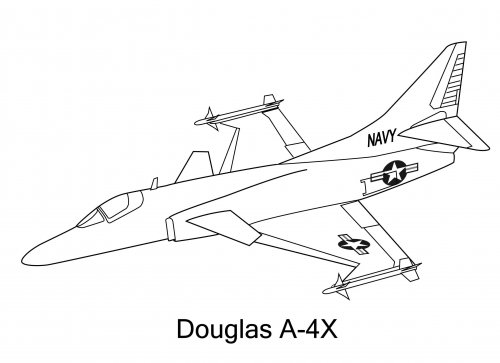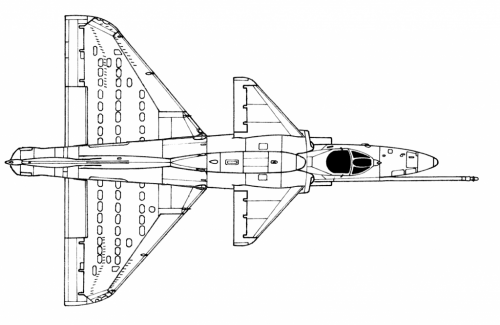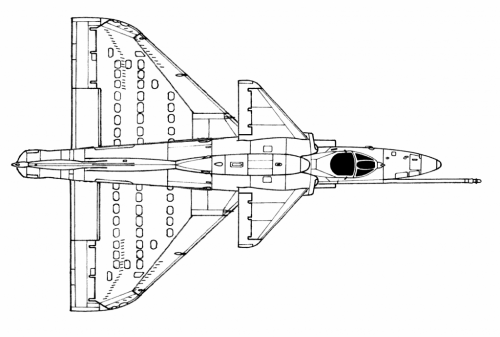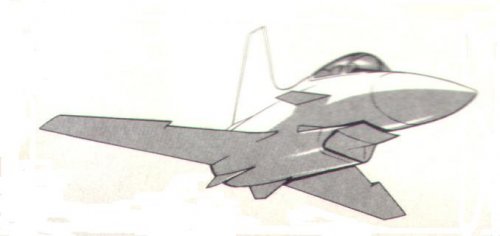You are using an out of date browser. It may not display this or other websites correctly.
You should upgrade or use an alternative browser.
You should upgrade or use an alternative browser.
A-4X
- Thread starter Tailspin Turtle
- Start date
- Joined
- 18 March 2008
- Messages
- 3,532
- Reaction score
- 721
Tailspin Turtle said:Anybody got any details on this?
Total conjecture but as part of the USG's rejection of funding of the IAI Lavi several US aviation companies were asked to come up with alternative designs to meet the IDF requirement. Perhaps this is a McAir proposal?
Steve Pace
Aviation History Writer
- Joined
- 6 January 2013
- Messages
- 2,266
- Reaction score
- 166
Not to mention the wingtip modification to include Sidewinder AAMs.
Abraham Gubler said:Total conjecture but as part of the USG's rejection of funding of the IAI Lavi several US aviation companies were asked to come up with alternative designs to meet the IDF requirement. Perhaps this is a McAir proposal?Tailspin Turtle said:Anybody got any details on this?
Very interesting. One note I have states that it was a late 1970s design study with a turbofan engine. I had assumed that it was a non-starter for the Navy's VFAX program, which would put it in the early 1970s. However, A-4N production for Israeli concluded in 1976. It's conceivable that Douglas was aware of an emerging Israeli requirement for a strike fighter and that the A-4X was its unsuccessful attempt to propose a strike fighter with the benefit of A-4N commonality. According to the interweb, the Lavi program got started in 1980, to be powered by a PW 1120 turbofan engine, with development beginning in 1982.
- Joined
- 18 March 2008
- Messages
- 3,532
- Reaction score
- 721
Tailspin Turtle said:Very interesting. One note I have states that it was a late 1970s design study with a turbofan engine. I had assumed that it was a non-starter for the Navy's VFAX program, which would put it in the early 1970s. However, A-4N production for Israeli concluded in 1976. It's conceivable that Douglas was aware of an emerging Israeli requirement for a strike fighter and that the A-4X was its unsuccessful attempt to propose a strike fighter with the benefit of A-4N commonality. According to the interweb, the Lavi program got started in 1980, to be powered by a PW 1120 turbofan engine, with development beginning in 1982.
If that is the timeframe it would be out of the USG funded alternatives studies in the mid 1980s that were used to kill off the Lavi. However McAir seemed to place the most emphasis on these studies offering three different Israelised aircraft options: AV-8B, F/A-18 and F-15. This intense commercial interest in the Israeli market – as compared to the lukewarm approach from Northrop and GDFW – would support their study of a “Super Ahit”.
Source: Flight of the Lavi by Dov Zakheim
- Joined
- 27 December 2005
- Messages
- 16,415
- Reaction score
- 18,960
The front fuselage and canard have the feel of the McAir Model 263 VFAX. However the Lavi connection seems more likely to me than VFAX.
The Lavi was planned squarely as a Skyhawk replacement so an F404 engined, stretched A-4 with canards makes a lot of sense as an alternative project.

The Lavi was planned squarely as a Skyhawk replacement so an F404 engined, stretched A-4 with canards makes a lot of sense as an alternative project.
- Joined
- 27 December 2005
- Messages
- 16,415
- Reaction score
- 18,960
Somewhere around 1976 (Israel F-16 license production discussed) and before the start of Lavi around 1979 would make sense.
Bear in mind that the A-4M fitted with ARBS was initially planned as A-4Y, this presumably was the same timeframe as the A-4X proposal. A-4M with ARBS entered production in 1977 so this would seem to place A-4X prior to this.
Bear in mind that the A-4M fitted with ARBS was initially planned as A-4Y, this presumably was the same timeframe as the A-4X proposal. A-4M with ARBS entered production in 1977 so this would seem to place A-4X prior to this.
overscan said:Somewhere around 1976 (Israel F-16 license production discussed) and before the start of Lavi around 1979 would make sense.
Bear in mind that the A-4M fitted with ARBS was initially planned as A-4Y, this presumably was the same timeframe as the A-4X proposal. A-4M with ARBS entered production in 1977 so this would seem to place A-4X prior to this.
Interesting, if X were something other than a marketing gimmick. It would be nice to see dated documentation of the consideration of the A-4Y designation. ARBS proof of concept began in the mid-1960s with boilerplate testing in the late 1960s and early 1970s. The A-4M first flew in 1970 with basically the A-4F avionics, less the radar, suggesting that ARBS was planned for incorporation in production. Flight test of the Hughes ARBS at China Lake began about 1977 but no A-4M was delivered from Douglas with ARBS, including the last one in 1979. Non-test A-4Ms with ARBS were all retrofits, beginning in 1983. So a Y designation for the A-4M with ARBS could have been a possibility from the early 1970s through the early 1980s.
- Joined
- 25 June 2009
- Messages
- 13,745
- Reaction score
- 2,928
overscan said:The front fuselage and canard have the feel of the McAir Model 263 VFAX. However the Lavi connection seems more likely to me than VFAX.
The Lavi was planned squarely as a Skyhawk replacement so an F404 engined, stretched A-4 with canards makes a lot of sense as an alternative project.

You mentioned the Model "263" for VFAX. Yet the picture you posted is named "265" (which I think is the correct Model number).
DanielStarseer
ACCESS: Confidential
- Joined
- 17 January 2010
- Messages
- 70
- Reaction score
- 44
A sweet looking canard design, hard to believe that radical a departure may have evolved out of the A-4.
(Then again, follow the Northrop lineage from the F-5 thru the F-17 Cobra / F/A-18 Hornets...)
For the timeframe, it makes me wonder if this may have, in any way, strongly influenced SAAB's Gripen...forward of the tail section, the entire front end looks very much like it.
(Then again, follow the Northrop lineage from the F-5 thru the F-17 Cobra / F/A-18 Hornets...)
For the timeframe, it makes me wonder if this may have, in any way, strongly influenced SAAB's Gripen...forward of the tail section, the entire front end looks very much like it.
- Joined
- 27 December 2005
- Messages
- 16,415
- Reaction score
- 18,960
Stargazer2006 said:overscan said:The front fuselage and canard have the feel of the McAir Model 263 VFAX. However the Lavi connection seems more likely to me than VFAX.
The Lavi was planned squarely as a Skyhawk replacement so an F404 engined, stretched A-4 with canards makes a lot of sense as an alternative project.

You mentioned the Model "263" for VFAX. Yet the picture you posted is named "265" (which I think is the correct Model number).
Nope. It was Model 263. Model 265 was the VLF (vectored lift fighter) project.
http://www.secretprojects.co.uk/forum/index.php/topic,2839.msg75512.html#msg75512
ysi_maniac
ACCESS: Confidential
- Joined
- 26 January 2007
- Messages
- 81
- Reaction score
- 30
Should we assume it is supersonic?
BTW, I love it!
BTW, I love it!
DanielStarseer said:A sweet looking canard design, hard to believe that radical a departure may have evolved out of the A-4.
(Then again, follow the Northrop lineage from the F-5 thru the F-17 Cobra / F/A-18 Hornets...)
For the timeframe, it makes me wonder if this may have, in any way, strongly influenced SAAB's Gripen...forward of the tail section, the entire front end looks very much like it.
I am agree !
- Joined
- 21 December 2006
- Messages
- 1,132
- Reaction score
- 611
Seems there was an F-4X project for Israel (http://www.f-4.nl/f4_29.html), although ATS has lots of dubious content about this. Dated early 1970s. So maybe a related 'X' designation for an Israeli Skyhawk?
Perhaps also the canard A-4 was related to the canard YF-4E that flew in the 1970s - maybe the California side of the company tried to propose a FBW testbed?
I think the original Israeli 'Phantom 2000' was intended to have canards, so maybe any Skyhawk update would, although this A-4X looks very 'new', with extended fuselage etc.
Looks like a big job to make this A-4X work, and anyone looking at it might think an all new design made more sense for production. But as a testbed it would presumably make things quicker to mod an existing design (at least that would be the hope!).
Perhaps also the canard A-4 was related to the canard YF-4E that flew in the 1970s - maybe the California side of the company tried to propose a FBW testbed?
I think the original Israeli 'Phantom 2000' was intended to have canards, so maybe any Skyhawk update would, although this A-4X looks very 'new', with extended fuselage etc.
Looks like a big job to make this A-4X work, and anyone looking at it might think an all new design made more sense for production. But as a testbed it would presumably make things quicker to mod an existing design (at least that would be the hope!).
- Joined
- 21 December 2006
- Messages
- 1,132
- Reaction score
- 611
Seems the -X designator was used for 1970s exports to Israel - see:
http://www.secretprojects.co.uk/forum/index.php/topic,10358.msg97380/topicseen.html#msg97380
for F-14X and note F-4X in previous post in this thread.
So, A-4X looks like 1970s for Israel.
http://www.secretprojects.co.uk/forum/index.php/topic,10358.msg97380/topicseen.html#msg97380
for F-14X and note F-4X in previous post in this thread.
So, A-4X looks like 1970s for Israel.
taildragger
You can count on me - I won a contest
- Joined
- 2 November 2008
- Messages
- 384
- Reaction score
- 440
Are we sure that this is real?
If it was a proposal aimed at Israel, why would the drawing carry USN markings?
The drawing seems suspect to me - the forward fuselage is more crudely drawn than the main body of the airplane and seems to be rotated out of alignment with the tail.
If it was a proposal aimed at Israel, why would the drawing carry USN markings?
The drawing seems suspect to me - the forward fuselage is more crudely drawn than the main body of the airplane and seems to be rotated out of alignment with the tail.
- Joined
- 19 July 2016
- Messages
- 3,725
- Reaction score
- 2,682
That linked thread appears to have been deleted and can not be viewed.
- Joined
- 29 July 2009
- Messages
- 1,518
- Reaction score
- 1,512
- Joined
- 29 July 2009
- Messages
- 1,518
- Reaction score
- 1,512
According to the book Lavi: United States, Israel, and a Controversial Fighter Jet by Golan, the early Lavi resembled an A-4 with canards and a squared inlet.
"Yet even in when the first sketches for the airplane were publically released by IAI in 1983, and even as late as December 1984, when IAI released as artist's interpretation for the airplane, the aircraft portrayed continued to bear influence of the austere A-4 replacement from which it sprung, with a more squared-off ventral inlet and a nose radome so disproportionately small as to suggest nothing more than a tiny, compact radar of modest means."
The drawing originally posted shows a bifurcated inlet system as opposed to the ventral system, but squared-off, which could indicate that the design was possibly an early version of the Lavi.
"Yet even in when the first sketches for the airplane were publically released by IAI in 1983, and even as late as December 1984, when IAI released as artist's interpretation for the airplane, the aircraft portrayed continued to bear influence of the austere A-4 replacement from which it sprung, with a more squared-off ventral inlet and a nose radome so disproportionately small as to suggest nothing more than a tiny, compact radar of modest means."
The drawing originally posted shows a bifurcated inlet system as opposed to the ventral system, but squared-off, which could indicate that the design was possibly an early version of the Lavi.
Attachments
ZacYates
LHX SuperTeam fanboy
- Joined
- 26 December 2012
- Messages
- 149
- Reaction score
- 123
User ysi_maniac is fond of creating drawings like this - don't place much faith in them being in any way official, just his own imagination.Dynoman said:From a modelers forum. However, they do not reveal the origination of the idea.
Phantom Fanatic
the ATF program was truly great
- Joined
- 27 October 2022
- Messages
- 71
- Reaction score
- 77
The second photo makes the A-4 into a mini Saab Viggen, an interesting concept.From a modelers forum. However, they do not reveal the origination of the idea.
BlackBat242
OK, I changed my personal text ;)
- Joined
- 10 April 2013
- Messages
- 758
- Reaction score
- 1,834
Which is ironic, considering that the Viggen used a militarized version of the P&W JT8D - which was a turbofan version of the J52 which powered the A-4!The second photo makes the A-4 into a mini Saab Viggen, an interesting concept.From a modelers forum. However, they do not reveal the origination of the idea.
Yup, that completely blew my mind recently. The J52 went through the Viggen via a civilian variant from an airliner. Of course they had to create an afterburner for it, as neither a Scooter nor an airliner had it in the first place.
- Joined
- 8 January 2006
- Messages
- 1,605
- Reaction score
- 675
And a J52 with an afterburner almost made it as the PW1216 for the aborted "Super -7".
I have seen Northrop's response to IAI on the Lavi, working from the original concept with the F404. Northrop proposed a couple different blendings of the Lavi with the F-5G/F-20 and taking advantage of the ability to keep most of the airframe the same while producing single-seat and twin-seat fighters and a reconnaisance variant.
I have seen Northrop's response to IAI on the Lavi, working from the original concept with the F404. Northrop proposed a couple different blendings of the Lavi with the F-5G/F-20 and taking advantage of the ability to keep most of the airframe the same while producing single-seat and twin-seat fighters and a reconnaisance variant.
Similar threads
-
McDonnell Douglas DC-10-based ALCM carrier
- Started by Triton
- Replies: 6
-
When Was the First Strut-jet Ever Built?
- Started by KJ_Lesnick
- Replies: 2
-
-
McDonnell-Douglas Model 265 AFTI project
- Started by overscan (PaulMM)
- Replies: 75
-




